What is the name of this tool and where can I find one?

-

Win a Free Custom Engraved Brass Coin!!!
As a way to introduce our brass coins to the community, we will raffle off a free coin during the month of August. Follow link ABOVE for instructions for entering.
-

PRE-ORDER SHIPS IN SCALE TODAY!
The beloved Ships in Scale Magazine is back and charting a new course for 2026!
Discover new skills, new techniques, and new inspirations in every issue.
NOTE THAT OUR FIRST ISSUE WILL BE JAN/FEB 2026
You are using an out of date browser. It may not display this or other websites correctly.
You should upgrade or use an alternative browser.
You should upgrade or use an alternative browser.
La Créole 1827 by archjofo - Scale 1/48 - French corvette
Hello Johann,
Your attention to detail continues to amaze me. But even more so your ability to reproduce those details at scale. Inspiring!
Your attention to detail continues to amaze me. But even more so your ability to reproduce those details at scale. Inspiring!
- Joined
- Aug 8, 2019
- Messages
- 5,522
- Points
- 738

That is called a 'Marlin spike'. Sailers use this. I think Johann made this out a injection needle.What is the name of this tool and where can I find one?

- Joined
- Nov 10, 2019
- Messages
- 469
- Points
- 373

@Mecanizados
Hello,
thank you very much for the praise.
The spot glued with superglue (yellow arrow) is replaced by the
rope binding covered.
I hope that the picture makes the process clear.
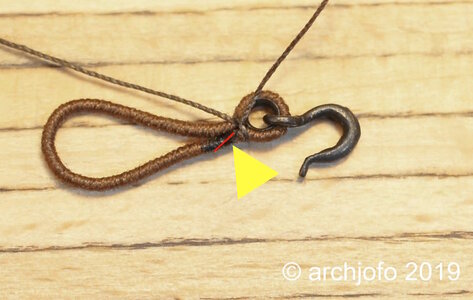
Hello,
thank you very much for the praise.
The spot glued with superglue (yellow arrow) is replaced by the
rope binding covered.
I hope that the picture makes the process clear.

- Joined
- Nov 10, 2019
- Messages
- 469
- Points
- 373

@Steef66
@Tobias
@Peter Voogt
@dockattner
Hello,
I am always happy about positive reactions. That's good for motivation.
@DARIVS ARCHITECTVS
Hello,
Stephan @Steef66 thankfully answered your question correctly.
It's just a cannula and I've softened the sharp edges, otherwise the yarn would be cut.
@Tobias
@Peter Voogt
@dockattner
Hello,
I am always happy about positive reactions. That's good for motivation.
@DARIVS ARCHITECTVS
Hello,
Stephan @Steef66 thankfully answered your question correctly.
It's just a cannula and I've softened the sharp edges, otherwise the yarn would be cut.
- Joined
- Nov 10, 2019
- Messages
- 469
- Points
- 373

@Mirek
Thanks for the positive affirmation.
I would also like to thank you for the many LIKES.
Continued: Equipment of the big yard - Blocks for buntlines and clewlines - Poulies de cargue fond et poulies de bouline
According to the relevant table in the monograph, the blocks for the buntlines and clewlines are only 3.4 mm long and 1.3 mm thick at a scale of 1:48. With this block size, the sheaves with a thickness of d= 0.5 mm are not used separately, but worked out. In total I need 12 blocks for the main yard and fore yard.
Before I start "series production", I made a "prototype" in the usual way and equipped it with a served strop. The eye is used to attach to the jackstay.
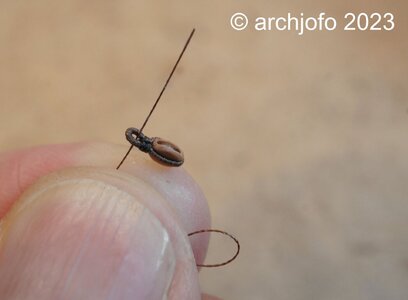
In the following image I have shown different block types and sizes compared to a block for a buntlines.
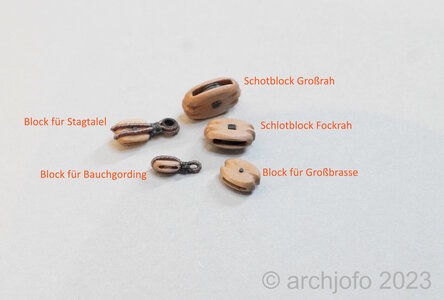
The next picture shows how these blocks are attached to the jackstay by means of tying.
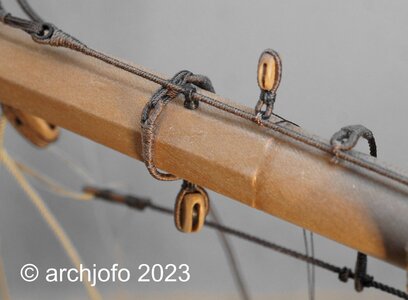
Sequel follows …
Thanks for the positive affirmation.
I would also like to thank you for the many LIKES.
Continued: Equipment of the big yard - Blocks for buntlines and clewlines - Poulies de cargue fond et poulies de bouline
According to the relevant table in the monograph, the blocks for the buntlines and clewlines are only 3.4 mm long and 1.3 mm thick at a scale of 1:48. With this block size, the sheaves with a thickness of d= 0.5 mm are not used separately, but worked out. In total I need 12 blocks for the main yard and fore yard.
Before I start "series production", I made a "prototype" in the usual way and equipped it with a served strop. The eye is used to attach to the jackstay.

In the following image I have shown different block types and sizes compared to a block for a buntlines.

The next picture shows how these blocks are attached to the jackstay by means of tying.

Sequel follows …
Wahnsinn, Johann, Wahnsinn, you are just a joy to watch.
You could try something like: Embroidery Punch Needle or Clover Kantan Couture needle. Available ex uncle Ali. These could serve you as miniature marlin spikes.What is the name of this tool and where can I find one?

- Joined
- Nov 10, 2019
- Messages
- 469
- Points
- 373

@pianoforte
Hello Adi,
Thank you for your nice comment. I'm glad you like it.
@ConsNZ
Hello,
Thank you very much for your tip, but this does not work with these needles.
On the one hand they are apparently too thick, on the other hand the hole is not an advantage for what I do with it.
I've been getting along very well with my self-made marlin spikes from a cannula ø 1.2 mm and ø 0.8 mm for a long time.
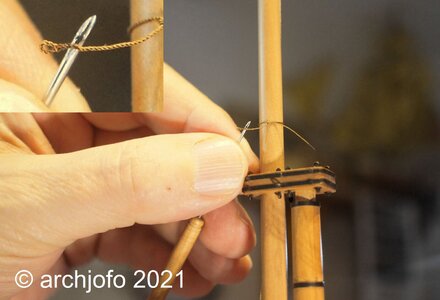
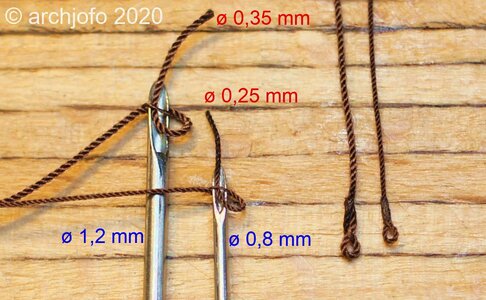
Hello Adi,
Thank you for your nice comment. I'm glad you like it.
@ConsNZ
Hello,
Thank you very much for your tip, but this does not work with these needles.
On the one hand they are apparently too thick, on the other hand the hole is not an advantage for what I do with it.
I've been getting along very well with my self-made marlin spikes from a cannula ø 1.2 mm and ø 0.8 mm for a long time.


I was referring to these used by my daughter for her needle work. I'm sure they could be modified somewhat by those of us with lesser skills... BTW Wonderful work you are doing. Most enjoyable.@pianoforte
Hello Adi,
Thank you for your nice comment. I'm glad you like it.
@ConsNZ
Hello,
Thank you very much for your tip, but this does not work with these needles.
On the one hand they are apparently too thick, on the other hand the hole is not an advantage for what I do with it.
I've been getting along very well with my self-made marlin spikes from a cannula ø 1.2 mm and ø 0.8 mm for a long time.
View attachment 372940 View attachment 372941
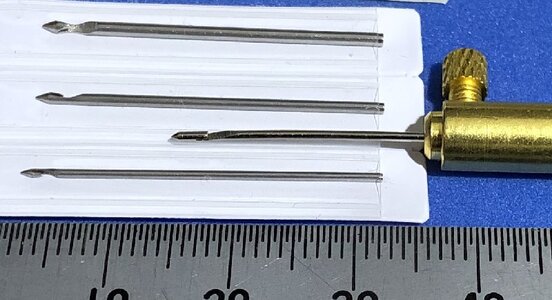
- Joined
- Aug 8, 2019
- Messages
- 5,522
- Points
- 738

We talk about a marlin spike, but that is a little incorrect. A marlin spike is actually a big needle without sharp point. Used to separate the strands. You can use a normal needle for this in modelbuilding. Just un-sharpen the tip.I was referring to these used by my daughter for her needle work. I'm sure they could be modified somewhat by those of us with lesser skills... BTW Wonderful work you are doing. Most enjoyable.
View attachment 373021
The cannula Johann is using, is based on a Swedish Fid or Dragonspike, a hollow marlin spike.
Here is a video where you can see the difference between them
Sorry Johan to break in your log.
Este trabajo ya no se puede superar, es increible
- Joined
- Nov 10, 2019
- Messages
- 469
- Points
- 373

@WojtasS
@ConsNZ
@Mecanizados
Thank you very much for the nice comments and the encouragement.
@Steef66
Hello Stephan,
all good, you explained it really well, thanks.
I would just like to add that with the thin ropes (ø 0.25 mm) it is very important that there is a hollow spike so that the rope can really be pushed through.
My pictures show what's going on.
@ConsNZ
@Mecanizados
Thank you very much for the nice comments and the encouragement.
@Steef66
Hello Stephan,
all good, you explained it really well, thanks.
I would just like to add that with the thin ropes (ø 0.25 mm) it is very important that there is a hollow spike so that the rope can really be pushed through.
My pictures show what's going on.
ahhh! now I understand clearly. This answer is very much appreciated as is the video link further explaining the difference [Swedish fid/Dragonspike] I'm familiar with a Marlin Spike as one was given to me several decades ago but I've never heard of a DragonSpike. Steef66 your knowledge, tuition and selflessness in passing on all and any information you've accumulated over the years is simply outstanding and a credit to your persona. Kudos to you. Cheers.We talk about a marlin spike, but that is a little incorrect. A marlin spike is actually a big needle without sharp point. Used to separate the strands. You can use a normal needle for this in modelbuilding. Just un-sharpen the tip.
The cannula Johann is using, is based on a Swedish Fid or Dragonspike, a hollow marlin spike.
Here is a video where you can see the difference between them
When you work on a little scale you will discover that Johann is right about the fact that a needle will not work and a cannula does. I tried both and a cannula is perfect in this case because you keep the shape in your rope. With a needle you have to tear the strands to much from eachother to get the rope between the strands.
Sorry Johan to break in your log.
I am catching up my "Today in Naval History"-topic and found, that the Creole was launched at th 5th May (sorry, that I am 3 days too late)
Today in Naval History - Naval / Maritime Events in History
5 May 1829 – Launch of French Créole, a 24-gun Créole-class corvette of the French Navy
Today in Naval History - Naval / Maritime Events in History
5 May 1829 – Launch of French Créole, a 24-gun Créole-class corvette of the French Navy
Naval/Maritime History - 5th of May - Today in Naval History - Naval / Maritime Events in History
Today in Naval History - Naval / Maritime Events in History 4 May 1945 - USS Morrison – On 4 May 1945, in the Battle of Okinawa, the US destroyer was sunk after being hit by four kamikaze aircraft. After the fourth hit the destroyer, heavily damaged, began to list sharply to starboard. Two...
shipsofscale.com
Johann,
I have to say I can't stop being amazed. I'm still enthusiastic and look forward to seeing your progress every time, it's not just the admiration in itself how exactly you proceed, it's also the never-ending learning process that I / we get from you. Just great work.
I have to say I can't stop being amazed. I'm still enthusiastic and look forward to seeing your progress every time, it's not just the admiration in itself how exactly you proceed, it's also the never-ending learning process that I / we get from you. Just great work.
- Joined
- Nov 10, 2019
- Messages
- 469
- Points
- 373

@ConsNZ
@Uwek
@Tobias
Thank you for your interest and the nice posts.
Continued: Equipment of the main yard - Blocks for buntlines and clewlines - Poulies de cargue fond et poulies de bouline
In the meantime I have made 12 blocks l = 3.4 mm for the blocks for buntlines and clewlines of the lower yards. I tried to make the seizing as small as possible, which wasn't easy with this size.
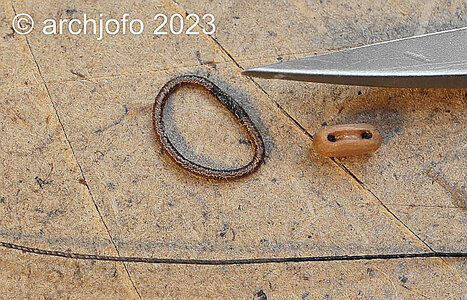
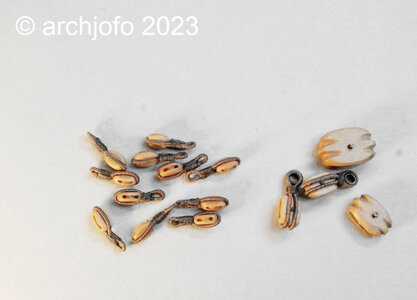
These blocks were moored to jackstay as shown in the following images.
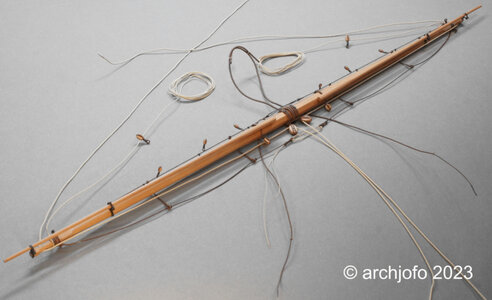
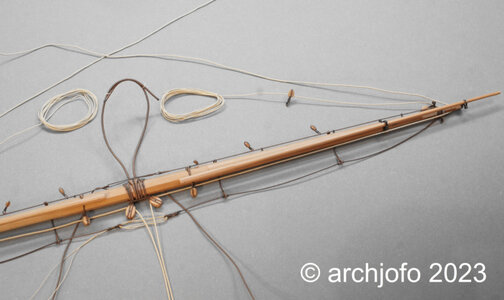
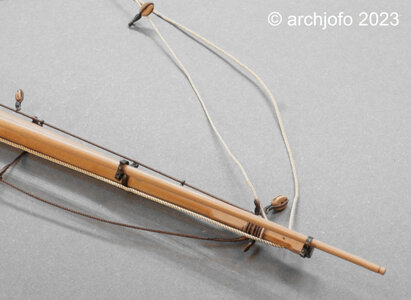
I will make my model of the La Créole without the sails, as I have already mentioned several times, analogous to the Paris model. Nevertheless, I would like to attach the arrangement for the clews of the lower sails. These rigging elements are not shown on the original model, so the sheets, tacks and clewlines with the necessary blocks are missing.
At the moment I'm still researching whether single or double tacks were used at La Créole. It still needs to be clarified how the fore tacks were led to the mooring cleats, as there is no information on this in the monograph. There is also another question, whether the French also use cable-laid ropes for the tack ropes?
Up soon …
@Uwek
@Tobias
Thank you for your interest and the nice posts.
Continued: Equipment of the main yard - Blocks for buntlines and clewlines - Poulies de cargue fond et poulies de bouline
In the meantime I have made 12 blocks l = 3.4 mm for the blocks for buntlines and clewlines of the lower yards. I tried to make the seizing as small as possible, which wasn't easy with this size.


These blocks were moored to jackstay as shown in the following images.



I will make my model of the La Créole without the sails, as I have already mentioned several times, analogous to the Paris model. Nevertheless, I would like to attach the arrangement for the clews of the lower sails. These rigging elements are not shown on the original model, so the sheets, tacks and clewlines with the necessary blocks are missing.
At the moment I'm still researching whether single or double tacks were used at La Créole. It still needs to be clarified how the fore tacks were led to the mooring cleats, as there is no information on this in the monograph. There is also another question, whether the French also use cable-laid ropes for the tack ropes?
Up soon …
Last edited:



